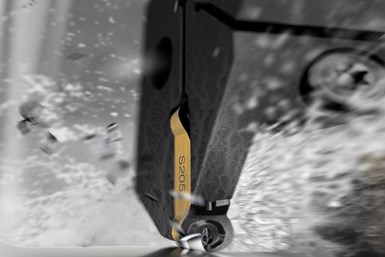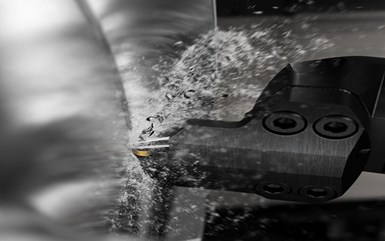
This chemical vapor deposition (CVD) grade is said to offer increased productivity through higher cutting speeds when semifinish- and finish-machining heat-resistant super alloys. Photo Credit: Sandvik Coromant
Heat-resistant super alloys (HRSAs) are typically used for aircraft parts that face extreme performance demands. Their high strength at elevated temperatures means the materials can retain their hardness despite intense heat. The demand for lower emissions, higher fuel efficiency and power density in the transport and energy makes HRSA materials particularly valuable in these applications.
Because HRSA materials are metallurgically composed to have high strength at temperatures as high as 1,000°C, the stresses generated when machining them are also high. The unique capability of these nickel, iron and cobalt-based super alloys to perform close to the melting point of their base metal means they have poor machinability characteristics.
Cutting tool manufacturer Sandvik Coromant says it has developed two new turning grades — S205 and CC6165 — that are optimized with these machining challenges in mind.
Designed for last-stage machining applications in aerospace engine components, S205 is a chemical vapor deposition (CVD) grade that offers increased productivity through higher cutting speeds in semifinishing and finishing applications. This insert is coated with the company’s second-generation Inveio coating for high wear resistance and long tool life, and its mechanical properties have been modified for improved strength via post-treatment technology. The Inveio coating forms tightly packed, unidirectional crystals around the insert to create a strong protective barrier, while delivering high thermal protection to reduce crater and flank wear.

Because HRSA materials are metallurgically composed to have high strength at temperatures as high as 1,000°C, the stresses generated when machining them are also high. Photo Credit: Sandvik Coromant
Well-suited for turning aged, nickel-based materials and pre-machined surfaces for components such as aircraft engine turbine discs, rings and shafts, S205 is said to offer 30 to 50% higher cutting speeds than other HRSA insert turning grades without compromising tool life. In fact, Rolf Olofsson, product manager at Sandvik Coromant, says analysis has demonstrated a 210% increase in tool life when using the S205 to machine an aged Inconel test bar, compared to results from a competing tool.
In addition, the CC6165 turning grade is made from SiAlON ceramic, a specialist class of high-temperature refractory materials offering high strength at high temperature. The company says it is optimized for roughing and intermediate-stage machining of HRSAs as well as for profile and general turning applications for components similar to those mentioned above.
It succeeds its predecessor, the CC6160 turning grade, by offering improved edge line toughness for secure machining of more demanding HRSA surfaces. It also achieves higher metal removal rates, helping to increase productivity and reduce the cost per component, the company says.
Related Content
-
The Value of Mass Finishing, Shot Blasting for Aerospace and Medical Applications
The choice between mass finishing and shot blasting for CNC-machined parts depends on the specific requirements of the application.
-
Sandvik Coromant Inserts Provide Stable Turning of Aerospace Components
The new insert grades GC1205 and GC1210 cover a large application area within last-stage machining and intermediate-stage machining when turning aerospace engine components.
-
JR Machine Launches Expansion Strategy, Hires New CEO
An investment from Schneider Resources Holding positions JR Machine to grow in emerging markets such space exploration and green energy.













.png;maxWidth=300;quality=90)



